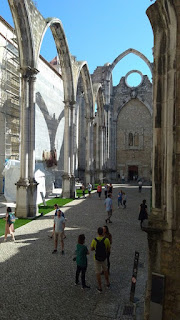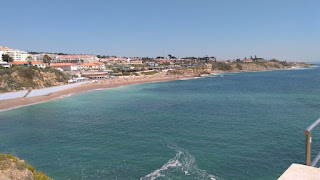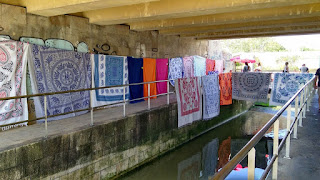 |
| A nice sand sculpture on the boardwalk along the shore in Lisbon. |
Last week I had an opportunity to attend the DaySol 17
conference in Lisbon. This was a small
conference of ~70 people working in printed electronics and low cost next
generation solar technologies. There was
an attempt to focus on industrial players and markets for devices, not only scientific research. The conference was
tied to a meeting of a European Union-funded project that my colleague has been
leading for the past three years. I knew
about half the people there from prior conferences, so it was nice to reconnect
with them and to meet some new people.
Several of us are working on collaborative experiments together, which I
enjoy. I had two posters at the
conference and my data was also shown in one of the oral presentations by my
collaborator. We had one official dinner out as part of the conference and there was traditional music played on a Portuguese guitar.
 |
| Portuguese guitar |
I had never been to Lisbon or to Portugal before. I really don’t know Portuguese history as well as
I should. I do know that they had a
wonderful and inexpensive public transit system with trains, a metro, trams,
trolley cars, funiculars, and buses. Most
notable, it includes the Santa Justa Lift, an elevator that appears to go to
nowhere (actually it does connect to the top of steep neighboring hill behind
it).
 |
| Santa Justa Lift |
 |
| A panoramic view of Lisbon from the top of one of the seven hills near the top of the Santa Justa Lift. |
The elevator was built in 1901 by Raoul Mesnier du Ponsard, a
disciple of Gustavo Eiffel, and was converted from a steam engine to an
electric motor in 1907. You can see more
pictures and read about it here. Every time I went by the lift the line was
incredibly long, so I did not ride it, but I did hike up the hill and enter it
from the top side where there is a small café and no lines.
In many ways the city of Lisbon reminds me of San Francisco,
but warmer and far less wealthy. It is
the city of seven hills, and the hills are steep. Buildings are close packed and colorful with
tiles rather than paint for decoration.
 |
| Square at the top of one of the hills. |
 |
| Local government buildings with nice tiles. |
 |
| One of the few beautifully restored buildings. |
 |
| A snack shop with beautiful tiles. |
 |
| A smaller scale building also with nice tiles. |
 |
| No tiles, but my AirBnB is marked by the circle. We had the whole 2nd floor. |
There are more standard European aspects as well, old
churches, castles, cobblestones (white with black inlayed patterns) big plazas
and markets.
 |
| Black and white cobblestones are inset all over Lisbon. |
 |
| A big plaza with outdoor markets and more cobblestone artwork. |
Near the top of the Santa
Justa Lift is the Igreja do Carmo Church (without a roof). This hilltop church was built in the 13th
century, but was devastated by an earthquake in 1755. They started to rebuild it, but then stopped and
preserved its ruins. It is now an
archeological museum, with a rather eclectic collection.
 |
| Igreja do Carmo Church (without a roof). |
One thing I did enjoy seeing there were
samples of older tiles from the 15th and 16th century in
Lisbon.
 |
| 15th and 16th century tiles in the Archeological Museum within the church. |
 |
| More modern tiles in one of the many beautifully decorated Metro stations. |
I guess Lisbon is famous for tin
cans of fish, and there were several stores that celebrate this with souvenir
sardine cans, which is a bit different from other cities.
 |
| This shop sells souvenir sardines in cans. They have different can designs by year. You are supposed to buy the ones from your birth year, but they have a hostess who clearly explains in English the that the sardines are not that old! |
 |
| There are some wonderful old trees in Lisbon. These are near the Botanical Garden. |
Outdoor markets and stands were all over town, but not the
type of sellers I see in Barcelona, who have canvas bags that they scoop up when the
authorities are coming. I declined the
chance to buy drugs a few times in the busy tourist filled plazas.
A local treat I did enjoy were egg custard
pastries called “natas”, which are delicious and sold everywhere. They originate from a city a bit west of
Lisbon, Belém. My Pomona student urged
me to go there and the shop there serves them hot all day long with sugar and
cinnamon on the side. That was the
best. I did not take a picture, but there are very nice pictures of the bakery where I went, Pasties de Belém, online. All the ones I had in Lisbon were
cold and plain, but still very tasty.
The city has segments that are in need of repairs and one
has the impression the economy has been struggling. Of course there are some very wealthy people
here, but it felt like many people were just getting by. Prices were lower than I have been seeing in
Spain. Tourists were everywhere I
went. On the Metro I met a French group having a bachelorette party for their friend. The bride-to-be had to wear a crazy costume
and it seemed like some type of scavenger hunt or bucket list was
involved. She asked me to pose for a
picture with her because I had a moustache.
 |
| A lovely French bride-to-be asked me to pose with her on the Metro. |
I spent Saturday morning exploring in central Lisbon on foot
with friends, but for the afternoon I took the train out along the Atlantic coast
to see nearby beach towns. It was a
beautiful day and the train was packed.
There was a wide diversity of people all headed to various beaches.
I got as far as Sao Pedro do Estoril, where I
had a great lunch at a local restaurant. Later I walked back along the coast two
train stops to
Carcavelos, which has
the Forte de São Julião da Barra at the east end of the beach. It was warm out and the water was cool (I
only went knee deep) with a rocky coast between the beaches. On my way back I got off the train in Belém, before
taking a bus back into Lisbon.
 |
| Sao Pedro do Estoril Beach |
 |
| The clifftop walking path between the beaches. |
 |
| A rocky section of the Atlantic coast. |
 |
| Waves coming off the Atlantic Ocean into the rocks. |
 |
| Blankets and towels for sale in underpass that provides access to the beach. |
 |
| Carcavelos Beach |
 |
| Palace in Belém |
The only real problem on this trip was that my flight was
supposed to land in Barcelona at midnight, but was delayed 2 hours, meaning not
only was I up late, but there were no trains back to San Cugat after 2am. I hired a cab and hope to get
reimbursed. We’ll see.


























No comments:
Post a Comment